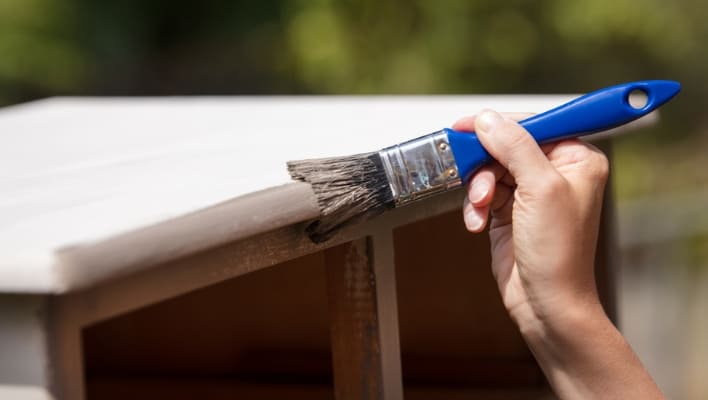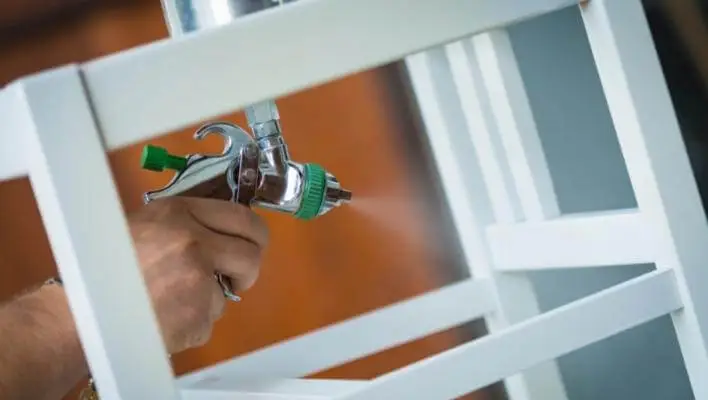Rattan furniture is known for its natural beauty and durability, but over time, it may start to wear and tear, including fading or becoming discolored. According to Reader’s Digest, rattan wicker furniture may get fragile and prone to breakage when exposed to extreme temperatures, a study conducted by Reader’s Digest (source).
When rattan furniture is exposed to extreme heat, such as direct sunlight, the natural oils and resins within the rattan can begin to evaporate. As a result, the once-flexible and robust rattan fibers become brittle and dry while the color of the furniture also fades over time. So, to revive its glory, can you paint rattan furniture?
Refinishing rattan furniture is a simple DIY task that you can tackle at home. Whether you want to revive an antique rattan wicker piece or add a pop of color to your outdoor patio set, all you need are a few basic tools and a high quality paint.
So, continue reading to learn the process of painting rattan furniture, with step-by-step guidance on how to transform your beloved pieces into stunning additions to your home decor.
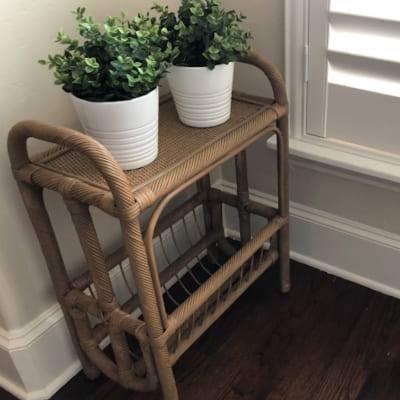
Table of Contents
- Can You Paint Rattan Furniture?
- What Kind Of Paint Do You Use On Rattan Furniture?
- Step 1: Gather Your Painting Tools & Supplies
- Step 2: Clean the Rattan Furniture
- Step 3: Sand the Surface (Optional)
- Step 4: Apply Primer
- Step 5: Apply Paint
- Step 6: Final Touches
- Tips For Painting Rattan Furniture
- Final Thoughts
- FAQs On Can You Paint Rattan Furniture
- Q. Can you use a brush for painting rattan furniture?
- Q. Do you have to sand rattan furniture before painting?
- Q. Is it worth painting rattan furniture?
- Martina Hitchcock
Can You Paint Rattan Furniture?
You won’t believe that painting my old faded rattan wicker cost me only $40 in total. Indeed, it’s quite surprising that painting your rattan furniture isn’t only a cost-effective solution to restore but also allows you to express your personal style and match it with your home decor.
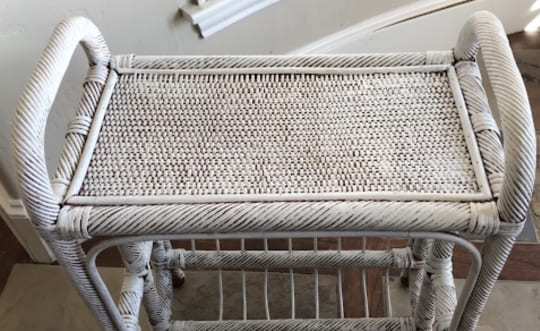
So, why not give it a try? Here’s a step-by-step guide on how to paint rattan to look natural but before that you need to know the best kind of paint you can use on rattan furniture.
What Kind Of Paint Do You Use On Rattan Furniture?
Rattan, woven and wicker furniture can be painted using various options such as milk paint, mineral paint, acrylic, chalk paint, oil-based paint, or urethane. When opting for mineral, chalk, or milk paint, self-sealing paint is also a good pick. Self-sealing paint eliminates the need for an additional clear top coat or wax for sealing the paint onto your furniture piece.
A great option that I would recommend is Rust-Oleum 2X Ultra Cover Spray Paint. I used it on my wicker piece, and I found this paint to be the best spray paint for rattan furniture, as it is highly durable and long-lasting. It adheres well to the surface of the furniture and doesn’t chip or peel easily, even with regular use.
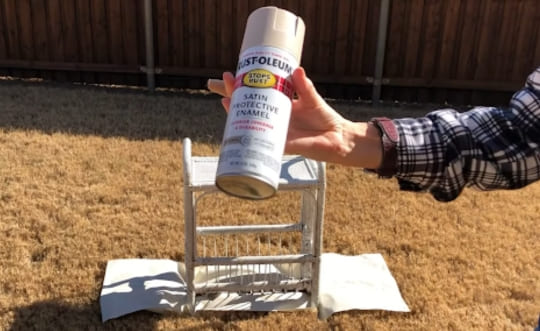
Apart from its ease of application, this paint has many other advantages. The consistency of Rust-Oleum acrylic enamel paint is just right; not too thick, not too thin. Upon application, it flowed smoothly over my rattan furniture, ensuring a professional appearance.
Additionally, Rust-Oleum acrylic enamel paint dries quickly. I didn’t have to wait around for hours between coats, which sped up the painting process significantly. Plus, the low odor was a definite plus, making the painting experience much more pleasant.
Step 1: Gather Your Painting Tools & Supplies
- Rag
- Paintbrushes or toothbrush
- Primer
- Paint
- Drop cloths or newspaper
- Cleaning soap or detergent
- Safety gear
Step 2: Clean the Rattan Furniture
Begin the painting process by wearing safety gloves. Before you start painting, make sure the rattan furniture is thoroughly cleaned so any dirt, dust, or lint can be removed. Prepare a mild cleaning solution by mixing mild detergent with warm water.
Dip a rag into the soapy water and delicately scrub the entire surface of the furniture. Use a paintbrush or small tooth brush to get into the crevices and tight spots. Wipe your furniture with clean water and let it dry completely.
Useful Resource: If you would like to learn more about how to repair rattan furniture, you can read our detailed guide!
Step 3: Sand the Surface (Optional)
If your rattan furniture has rough or bumpy surfaces and you want to know how to remove varnish from rattan furniture, you can lightly sand it with fine-grit sandpaper to create a smudge-free painting surface. This step is optional, but it could help the paint adhere better.
Step 4: Apply Primer
Primer is essential for adhesion and ensuring the paint adheres evenly to the rattan. I used Aqua Lock Plus Acrylic Water-Based Primer, which is known for its excellent adhesion and sealing properties. Using a paintbrush or paint sprayer, apply primer evenly over the rattan surface. Smoothen the rattan fibers by working in their direction. Allow the primer to dry thoroughly that could take a few hours.
Step 5: Apply Paint

Acrylic or enamel paints work well for rattan furniture. Make a statement with a vibrant color or go bold with a color that complements your existing decor.
To paint my rattan patio set, I used Rust-Oleum Painter’s Touch 2X Ultra Spray paint that worked beautifully and offered excellent coverage. The semi-gloss finish gave my outdoor space a touch of elegance.

Apply Rust-Oleum paint in the direction of the rattan fibers to maintain a uniform look and multiple coats are advisable for full coverage.
Step 6: Final Touches

Once the paint has dried completely, inspect the furniture to see if any touch-ups are needed. Use a small toothbrush or paintbrush to fix any imperfections.
Once paint is dry, your beautifully transformed furniture is good to be placed back in its desired location. Admire the painted rattan furniture and how it complements your decor!
Update: I’ve just completed this project featuring handcrafted rattan furniture, meticulously painted with a glossy red acrylic finish. Take a moment to admire the stunning transformation!
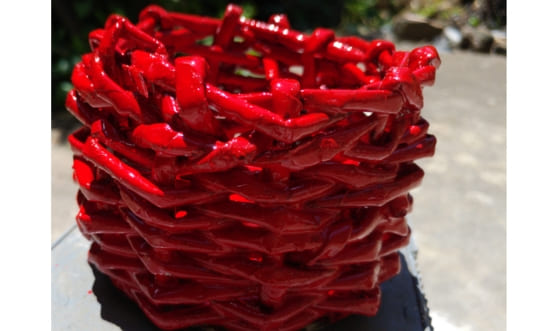
Tips For Painting Rattan Furniture
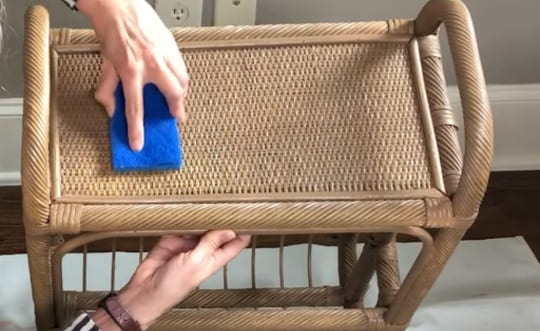
When I was painting my rattan wicker, I applied some fantastic techniques for achieving a stylish and unique look:
- To give my rattan furniture a trendy ombre effect, I used multiple shades of the same color to create a trendy ombre effect, blending from top to bottom for a unique appearance.
- I wanted to add a touch of luxury to the rattan piece so I started with a neutral base coat and added metallic paint to highlight edges and details.
- For a more contemporary and eye-catching look, I decided to implement some painted rattan furniture ideas. I experimented with bold color-blocking techniques by dividing the wicker into distinct color zones, creating a striking contrast between different sections.
Final Thoughts
Painting rattan furniture is a cost-effective and creative way to revitalize your pieces and give them a fresh look. With some basic supplies and a little patience, you can easily change the look of your old and faded rattan furniture into stunning additions to your home decor.
Plus, you’ll have the satisfaction of knowing you did it yourself, adding a personal touch to your backyard space. Moreover, if you find yourself confused during the painting project, you can come again to this article on “can you paint rattan furniture” and get help completing your DIY task.
FAQs On Can You Paint Rattan Furniture
Q. Can you use a brush for painting rattan furniture?
You can easily apply oil-based paints to your rattan furniture using a brush in different colors.
Q. Do you have to sand rattan furniture before painting?
Sanding rattan furniture before painting is generally not necessary. Rattan’s natural texture doesn’t require sanding like wood. However, your rattan furniture can be sanded with a fine-grit sandpaper to smooth out any uneven spots or imperfections.
Q. Is it worth painting rattan furniture?
Yes, you can paint rattan furniture if you want to change its color or give it a fresh look. Choose high-quality paint like rust-oleum paint with a quick drying time.

Martina Hitchcock
Martina Hitchcock is a versatile author with expertise in different fields. As a paint sprayer expert, she has in-depth knowledge of paint spraying techniques, tools, and equipment. Martina is also an experienced home remodeler who has worked on various projects, including kitchen and bathroom renovations, flooring installations, and room additions. Her knowledge of home improvement and remodeling is extensive, and she enjoys sharing her insights and tips with readers. You can follow her on Facebook.

